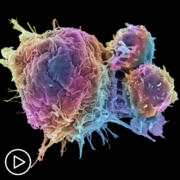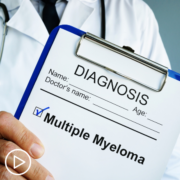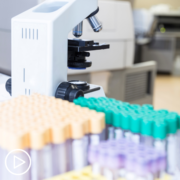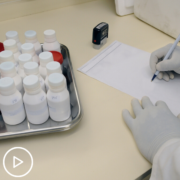Myeloma Patient Expert Q&A: Start Here from Patient Empowerment Network on Vimeo.
In this myeloma patient expert Q&A, Mayo Clinic expert Dr. Sikander Ailawadhi provides highlights around the myeloma novel alphabet soup and actionable steps on how patients and care partners can start the treatment conversation.
See More from START HERE Myeloma
Download the START HERE Myeloma Resource Guide
Related Programs:
Transcript:
Lisa Hatfield:
Hello and welcome, my name is Lisa Hatfield, your host for this Patient Empowerment Network program. In this important dialogue, we bridge the expert and patient voice to enable you and me as a myeloma patient to feel comfortable asking questions of our healthcare teams with more precision, more precision, the world is complicated, but understanding your disease doesn’t have to be. The goal is to create actual pathways for getting the most out of multiple myeloma treatment and survivorship. Joining me today is Dr. Sikander Ailawadhi, a respected multiple myeloma expert from Mayo Clinic. Thank you so much for joining us today, Dr. Ailawadhi, we really appreciate your time.
Dr. Sikander Ailawadhi:
Thanks a lot, Lisa, for having me, and I look forward to this program.
Lisa Hatfield:
Okay, so before we get started, please remember to download the program resource guide via the QR code, and we are going to jump right into a discussion about some of the novel therapies that there is much buzz about right now, and it’s kind of an alphabet soup these novel therapies. I actually was trying to digest all of this information and divide it into the general categories. And correct me if I’m wrong, but we have monoclonal antibodies, we have bispecific antibodies like the CAR-T therapies, and they target different things. We have BCMA, we have GPRC5D, FcRH5, we have things called antibody drug conjugates and cell mods.
So, Dr. Ailawadhi, if you can just give us kind of a broad overview of these therapies and how they may be used to harness our immune system, and how they come into play when you’re treating your patients, how and when they come into play when treating your patients.
Dr. Sikander Ailawadhi:
Surely, so I think thanks a lot for bringing up that discussion, this is extremely important, and I think it’s most important because if a myeloma patient goes online and wants to search for information or research, these things start coming up this term starts coming up. So it’s extremely important for a knowledgeable and empowered patient to learn about these, understand them, so that they are able to digest that information.
And I should mention that a lot of what we’ll talk about about these particular treatments may not be applicable to newly diagnosed patients or a recently diagnosed patient, but this is important enough and exciting enough that I would want every single patient to pick up this information. Learn it hopefully, and maybe park it for now somewhere, so that hopefully down the road it becomes important and handy. So you asked about monoclonals, bispecific, CAR-Ts, cell mols, etcetera. Let’s take a step back, let’s think about these as strategies to target myeloma.
Myeloma treatment is going through a change where immunotherapy and harnessing the body’s own immune system is becoming extremely important. And when we do that, the immunotherapy is typically very targeted, so what these drugs these agents, these terms, this alphabet soup is doing is it is targeting specific markers on the myeloma cell on the plasma cell.
For example, one of the markers is CD38. There is a monoclonal antibody. There are actually two monoclonal antibodies. Daratumumab (Darzalex), rituximab (Rituxan) that are FDA-approved, but there are other ways of targeting CD38, for example, CD38 targeting CAR-T cells, CD38 targeting antibody drug conjugates, etcetera. So CD38 is one important part. A very, very, very important thing in the past one year or a year-and-a-half has been what’s called B-C-M-A, B cell maturation antigen. BCMA is another target on plasma cells. Very effective, very specific.
So there are many, many drugs that are available and becoming available to target BCMA. Right now, there are three drugs that are FDA-approved that can target BCMA. Two of them are CAR-T cells, a particular way of going after BCMA in which the body’s own T cells are collected. These are not stem cells, these are T cells, T lymphocytes, these T cells are collected, they are actually genetically modified to go and fight against the BCMA, and then those modified T cells are multiplied in the lab and given to the person as a drug, they go and seek the plasma cells because of BCMA kill them harnessing the body’s immune system.
So there are two CAR-T cells against BCMA, one called ide-cel (Abecma) and one called cilta-cel (Avekti). There has recently been available a bispecific antibody against BCMA, we call it bispecific because it connects to BCMA from one end and from a second it connects to the body’s T cells again, bring the T cells close to the plasma cells to kill them. Then bispecific antibodies called teclistamab (Tecvayli). And until recently there was another drug available against BCMA which was what’s called an antibody drug conjugate. This drug is called belantamab (Blenrep) for the timing, belantamab has been removed or withdrawn from the market in the US, but there are ongoing clinical trials and down the road, it may come back again.
Now, antibody drug conjugate is another way of targeting something in which there is a seeker for the BCMA in this case, and it has a payload of some kind of a toxin, so that when the drug connects to the plasma cell through the BCMA in this case, that toxin is released, it can kill the cell, so either we harness the body’s immune cells, the T cells by CAR-T or bispecific, or we kill the cell by releasing a toxic payload from a drug, antibody drug conjugate, these are all different methods of targeting the myeloma cell.
So I talked to you about monoclonal bispecific CAR-T and ADC as different strategies, CD38 and BCMA, some of these strategies are available, but there are other targets which are very exciting and new drugs are being developed against them, two of the very interesting targets there one is called GPRC5D, and the other is FcRH5.
These GPR5CD or FcRH5 are two different targets on myeloma cells. No drugs are currently FDA-approved, but they are being developed very rapidly, and we have a couple of extremely promising agents which will be coming down the pipe. And you also mentioned something called cell mods. Cell mods are some newer drugs in the family of what’s called IMiDs or immunomodulators, in which our patients may be aware of thalidomide (Thalomid), lenalidomide (Revlimid), and pomalidomide (Pomalyst). The cell mods are kind of the same family, and there are a couple of them that are also being developed.
So why is this important for everybody, whether they are newly diagnosed or relapsed or long-term survivor with myeloma, because this tells you that not only are we getting newer drugs in the same classes, we are also getting brand new classes of drugs. And you can imagine that means that those brand new strategies are ways to target the plasma cell, we know cancer cells are smart, and they develop invasive mechanisms to become resistant to drugs. But every time something gets resistant if we have a brand new mechanism to go against the disease, but that’s exciting because that’s why we are seeing deeper responses, even in very heavily pre-treated patients, because we are using newer specific, relatively safe, convenient strategies to going after the plasma cell.
I know that was a lot of information, but I hope this helps our listeners learn a little bit about what you rightly said is an alphabet soup, but I would like us to think about it as an exciting time for being a myeloma doctor, and certainly a very hopeful situation for all our patients.
Lisa Hatfield:
Thank you so much for that great description. And one question comes to mind that I have heard from other myeloma patients, and you mentioned that we are seeing deep responses, or they’re seeing deep responses in clinical trials for some of these in refractory relapse patients.
Do you think that bringing these…do you think it’s possible to bring some of these therapies to the forefront of myeloma care, maybe an induction therapy or after first relapse, and if so, do you think that that could lead to even deeper responses in those patients because their immune system isn’t quite so tired and potentially cure?
Dr. Sikander Ailawadhi:
Again, Lisa, that is such an important and such a spot-on question that you’ve asked because absolutely, you can imagine, if we are thinking of harnessing the body’s immune system, the T cells, but we’re talking about patients who have had five, six, seven, then, prior lines of therapy. But that immune system is also a little exhausted, a little tired, but if you were to use the immune system of a newly diagnosed patient, patient who’s not been created that much…well, those T cells are going to be way more robust. Whether we use a CAR-T kind of strategy where we remove the T cells, train them and put them back, or we use a bispecific kind of strategy where we put in a drug that pulls the T cells closer to the myeloma cells and kills them using these smart thoughtful strategies which are not just dumb drugs that go in and kill everything, these are smart targeted drugs, using them early on in the treatment paradigm will certainly be more beneficial. In fact, there is some data showing up where some of these strategies like CAR-T cell are being used sooner in the treatment paradigm.
But again, as drug development goes, We first want to make sure it is safe, it is effective, and typically the starting point is patients who have exhausted other options, but very soon we will be seeing all of these strategies, and in fact, some of these strategies combined with each other coming in, early lines of therapy and hopefully providing excellent, deep responses, and you mentioned that term that has been very invasive for us cure, I don’t know if we are…
So we are not there yet. I don’t know how long it’ll take us to get there, but there is certainly much more hope today for getting to that cure than it was before.
Lisa Hatfield:
Thank you, and I think as a myeloma patient and on behalf of other myeloma patients, hearing about all of this research and how our immune system is being used to help us, does give all of us hope to keep continuing, and then you want a moving forward. And I think that was probably a good time to step into some questions here that we’ve received from other patients who have written in prior to this program. I will start with those, but I do want to take a step back, first of all, we’re going to kind of talk about a newly diagnosed patient and all of your explanation of all of these different therapies, these are things that typically are talked about later in therapy as of right now.
It also reminds me to tell everybody that there is great importance in seeking out the expertise of a myeloma specialist, I think everybody heard what Dr. Ailawadhi had to say about these therapies, really, even if it’s just when you’re newly diagnosed, going for a consult once and then maybe upon relapse going again, if you don’t live near it, a specialist, seeking out the expertise of a specialist is really critical.
I think I’ve had to do that and I’m so thankful I’ve been able to…we do have resources that we can guide you forward at Patient Empowerment Network, but I think it’s really critical to seek out that expertise of a myeloma specialist. So now we’re going to jump into our questions. So, thank you again, Dr. Ailawadhi.
So we have a patient asking for newly diagnosed patients, say a patient comes into you, maybe they were sent by their community oncologist or a family practitioner, something…I have myeloma, doesn’t know anything about it. Have even heard of it before. How do you start that conversation? How did you explain myeloma and the treatment and very importantly to the patient, how do you explain the prognosis when you know it’s not curable yet?
Dr. Sikander Ailawadhi:
An extremely important question. And I agree that we should be starting at the beginning, so I think I had the privilege of working at an institution where we tend to spend a lot of face time with the patient, so typically in the outpatient, I have at least about an hour of time blocked is how we’re set up.
So at that visit, first of all, I’m hoping that a patient comes in with a caregiver, but if they don’t have a caregiver with them, I start off by asking them, Is there someone they would like us to call during the visit? Because it is always better to have a caregiver or an extra set of ears listening in, and once that has started, then I typically will explain to them literally from what is a plasma cell, what is the role of a normal plasma cell, because that tells us the type of proteins plasma cells produce.
And that leads us to how a plasma cell can become cancerous and lead to multiple myeloma, what are the signs and symptoms of multiple myeloma? What are the markers, these protein markers that come in the blood and are picked up as markers of disease for patients, because again, patients need to know what they’re looking for in the labs that are drawn, so very frequently.
We talked about the role of a bone marrow biopsy, a lot of times it has been done, sometimes it has to be done after that visit, we talk about the genetic mutations in plasma cells that can be seen because that is what helps determine the risk category of standard risk or high risk.
I do offer to patients about discussing the prognosis, again, it’s a good time where we know that the average survival of patients is close to about 8 to 10 years when they look at a general national data, U.S. data, but all the large centers, all of us who focus on myeloma, we have several patients who are living quite a bit in excess of 10 years, so more hopeful time, but it is important to put that prognosis in perspective with high risk or standard risk disease that can be determined based on mutation testing from the plasma cells from the bone marrow, something called the FISH test, part of it is to explain to the patient the prognosis, but other reason is also because sometimes that can determine the type of treatment, and this also importantly tells the patients about their disease much better, so they can be more educated, they can interact with other patients, they can ask the right kind of questions, and they can understand their disease process and follow-up better.
Now, after we have discussed all of this, we start talking about treatment, I can tell you when I talk to a newly diagnosed patient, I will tell them that in my way of thinking their treatment initially is broadly divided into three different discussions during three different visits. The initial visit is talking about any symptom or sign from the myeloma, increased calcium, kidney dysfunction and tumors, how are we going to tackle that? So we will come up with the right “induction regimen.”
I really don’t think one-size-fits-all, so based on the patient’s age, comorbidities, other diagnosis or the treatment drugs, family support system, financial situation, there are so many factors that go into it. We come up with an induction regimen, I’ll tell them that the second component is about controlling all the symptoms and manifestations of the disease, whether that means radiation therapy, bone-strengthening agents, multivitamins, minerals, whatever we need to do as supplements, then we’ll talk about…starting that treatment. What does it involve? Side effects, we will set that path, you will notice I have not even talked about transplant, and I’ll tell the patients that only thing I mentioned to patients in that first planning, visitors and down the road, we will be talking about transplant…
Today is not the time, because, in my experience at the moment, we start talking about bone matter, transplant, stem cell transplant everything goes out the window. That’s what patients think about…and I don’t want them to do that. The second part of my discussion comes around a month or so into the treatment, because by then we want to start seeing some responses, some symptoms turning around, but that month two to three is very importantly the time to rebuild things.
Does the patient need to go to physical therapy, pain control? Supportive or palliative care services? Lipoblasty or tuboplasty to strengthen their spine. I mentioned physical therapy, I’ll say it again, because I really think that’s very, very, very important for controlling the pain and supporting the movement and quality of life, managing any side effects, making sure that the dose is correct, do we need to tweak the doses, etcetera. And at that visit is tell them that, “Okay, very soon we will be talking about…we’ll be going into the details of a transplant, we will be passing along more information to you. But at your next visit, which would be probably at that two- to three-month mark, two- to three-cycle mark,” is when I will really sit and talk to them about our transplant…
So for me, the main transplant discussion comes at that cycle to recycle the two to three, two to three cycles have already gone and patients feeling better, they are much more receptive for the next phase of treatment, which is when we talk about transplant, that’s how I do it, typically. And then we’ll explain a lot about what this transplant need…what does it involve? Caregiver needs a supportive care, vital organ testing, bone marrow biopsy, response depth, MRD, all of that.
So for me, this is kind of the journey that a patient, newly diagnosed patient goes through for the first few months, then their transplant, then their maintenance and hopefully good long disease control state.
Lisa Hatfield:
Great, how often do you expect a patient will have to have appointments during that…talk about the induction phase, the first month to three months, how often do you think they will have appointments, whether it’s for treatment or to come see you? What should they expect that way?
Dr. Sikander Ailawadhi:
Sure, so the regimens that we typically use in myeloma, some of them, the drugs are given twice a week, a majority of the way we give the drugs, it’s once a week, so one to two times a week would be visits, we do the labs for the first month, we will do sometimes every week, but by the time the patient has gone to the second or third cycle, once every two to four weeks, labs are reasonable because by then things have stabilized, but the treatment still would, I think the once or twice every week depending upon the regimen that they have, we don’t typically see the patient for a clinic appointment every time, but a lot of centers do, so every time the patient comes, as I said, one to two times a week, typically that translates to about four visits in every three to four weeks they coming on the cycle, some regimens are three week regimens, some regimens are four week regimens, etcetera.
So patients come, I can say that the first one to two months are most intensive for follow-up for labs, we want to make sure everything’s been fine, been start reading the treatment, they are not having side effects it and etcetera, and then things can be spaced out a little bit for the next couple of months before we go into the transplant thing, if the patient is going for transplant.
Lisa Hatfield:
Okay, well, great. Thanks for that information. It helps patients plan a little bit better to their life around myeloma and myeloma treatment, so we have a pretty specific question here about amyloidosis, so how often does amyloidosis occur in myeloma patients, and does it change the treatment if they do have amyloidosis?
Dr. Sikander Ailawadhi:
Excellent question again. So I would like to clarify that amyloid is a specific kind of different kind of abnormal protein that can be produced by plasma cells. All of us have these proteins that are…these proteins that are developed as very…or produced in the body is very small molecules and then they fold upon themselves to make different building blocks for the body. If that folding process is misfolded or abnormal, these amyloid fibers can develop and they can deposit anywhere in the body, and whatever the deposit they cause their symptoms. Now, amyloid can be present in two different ways, either amyloid is the primary problem and is being produced by the plasma cells, or sometimes patients who have multiple myeloma and are on treatment for multiple myeloma can either start developing some amyloid protein or…or they can have amyloid deposited in certain organ, heart, kidneys, like the gut, etcetera, the occurrence of amyloid in a myeloma patient, it’s not a common phenomenon, I would say anywhere in 10 to 15 percent of cases that we know of, maybe this present, others that we don’t pick, but once even we find out that amyloid is present in a case of multiple myeloma.
If, for example, amyloid is present in the heart, if we are using any drugs that may have some heart-related side effects, we may need to adjust doses, if amyloid is present in the kidneys, if you’re using some drugs that have kidney-related implications, we may need to adjust the dose, etcetera, broadly, the treatment stays the same, but there is a higher risk to kidneys, higher risk to heart, etcetera in amyloid patients or patients who develop amyloid, so we have to take that into account, sometimes choice of treatment changes, sometimes dose of treatment changes sometimes impact on certain organs change broadly. For a myeloma patient who develops amyloid, the treatment can stay very similar to what would have happened even if amyloid was not present, except some small tweaks.
Lisa Hatfield:
All right, thank you. Another question from a patient since my diagnosis and bone marrow transplant, my teeth have been deteriorating, is there a connection between dental health and myeloma?
Dr. Sikander Ailawadhi:
Very important question because although this is not a very common finding, it is something that really affects quality of life, so myeloma itself does not always or frequently cause teeth problems or dentition problems, which you can imagine teeth are bones. Myeloma affects bones, Myeloma affects calcium deposition in bone so teeth can get damaged in two or three different ways in myeloma patients, first, if myeloma involves the job or you can imagine that the teeth in that particular area could become loose or they could become a little off because the structure is getting affected.
Sometimes if my novels present on the job, for example, and radiation is given, but that bone becomes weaker, so teeth can become weaker, another way myeloma and dental health can be connected is because we use certain bone-strengthening agents for myeloma. These drugs are called either bisphosphonates, for example, or zoledronic acid (Zometa) or pamidronate acid (Aredia), patients may know as Zometa or Aredia, or there’s a second category called RANK ligand inhibitors, one of the drugs there is denosumab or Xgeva, these are all drugs that are given for bone-strengthening for myeloma. Patients are recommended to take calcium and vitamin D, but a rare but definitive side effect that is known to happen or can happen with these drugs is what’s called osteonecrosis of the jaw, where basically the jaw bone is becoming necrosed or less viable.
And you can imagine if the jaw is less viable, the teeth that go into the jaw in that spot, they’ll become loose and hurt, painful…it’s not a good condition to have it very…it affects quality of life significantly. So while it is rare, this osteonecrosis of the jaw can occur maybe less than 10 percent of the cases, but it is a significant morbidity-causing issue.
What I recommend to patients is that one, if that is happening, first of all, we’re not…we typically don’t continue that drug that is causing it, like a bisphosphonate or RANK ligand inhibitor. Secondly, the patient needs to see a good oral maxillofacial surgeon or a good dentist, preferably someone who has knowledge and experience in handling osteonecrosis of the jaw. So different ways in which myeloma treatment can affect the jaw, there is not a direct correlation, but in about 10 to 15 percent of cases, there may be jaw or teeth-related implications in myeloma patients either from the disease or its treatment like radiation or bone-strengthening drugs.
Lisa Hatfield:
Okay, thank you, and that’s a great segue into the next question we have from a patient, so if a patient cannot take bisphosphates doesn’t explain the reason why, are there other bone-building therapies that are recommended to protect them?
Dr. Sikander Ailawadhi:
Sure, so I would say that while we talk about these drugs like bisphosphonates, RANK ligand inhibitors, there are some other drugs that can be used to strengthen the bones, because you can imagine these bone-strengthening agents are used in a lot of different cancer, breast cancer, prostate cancer, etcetera.
So this family of drugs can be used, there are some that are used less frequently, but can be used instead of bisphosphonates and denosumab, but I would bring the patients back to even more basic stuff, calcium, vitamin D, exercise, bone-strengthening exercise. These are the first steps. Then come the other bone-modifying drugs, so even if a patient has been told that they cannot get any of those drugs because of the side effects, they could certainly say calcium vitamin D after discussing with their doctors, and they can regularly do some bone-strengthening building exercises sometimes it’s as simple as swimming, as simple as spinning, but those are like on the stationary bike, but those are extremely important activities to help build bone mass.
Lisa Hatfield:
All right, thank you. Have you ever had a patient that has reached complete response that you said, Well, maybe you don’t need to continue on bisphosphonates, that ever an option for patients to not continue after a certain period of time?
Dr. Sikander Ailawadhi:
Again, excellent question. And, in fact, historically, all the bisphosphonate-related clinical trials had up to a two-year follow-up, so a lot of times we used to say, “Well, at two years we need to stop them because there’s no safety data beyond that.” But more recently, there are studies that have shown that even every three months of bisphosphonates is as good as every month. So if somebody has active bone-affecting myeloma, then their treatment can be given every month or every three months.
But if a person has gone into remission, and remember, the myeloma was the inciting event that was causing the bone loss, if there is no disease, if there are no active bone lesions and the person is in good health, they are active…no bone-related issues. You’ve done imaging. Everything is good. I think it certainly it can be done that the bisphosphonate can be stopped. And, of course, this needs to be actively discussed with the patient, but frankly, other than having the side effect concern, if I can have a patient not come in for a treatment and they can spend that much extra time with their family doing what they want to…I think that’s a win-win.
Lisa Hatfield:
All right, thank you. So another patient asking, I was told I’m in remission, but my light chain numbers are going up and the lambda is low. Are small fluctuations common?
Dr. Sikander Ailawadhi:
Very good question. And very important to keep in mind, yes, small fluctuations in light chains can happen as the patient mentioned, they said their light chain are going up, but lambda is low, so I’m assuming they’re talking about their kappa light chains higher and the lambda low. For light chains, the most important thing is that we don’t want just an individual isolated value, we want to see a trend if there is an upward trend in one of the values, the abnormal light chain, that is certainly a concern if the involved or the higher light chain is stable.
But the uninvolved or the lower light chain continues to go down. Well, that is still of concern, but may not mean that the disease is coming back, it may mean that the immune system is getting affected a little. All said and done, light chains are very volatile, they are very…they can fluctuate, they can get affected by our kidney function, they can get affected by our hydration status. So if there is a concern with light chains, they should be re-checked and there is a persistent movement of light chains in a certain direction that is an important time to figure out, is the disease coming back or is there another reason that the light chains are changing.
Lisa Hatfield:
Okay, how often do you check those labs in your patients, their light chain?
Dr. Sikander Ailawadhi:
For somebody who’s on active treatment, we check the light chains, we do the whole panel of myeloma lab reassessment with? Electrophoresis, immunoglobulins, light chains, we do that on a monthly basis for somebody who’s on active treatment, that they are… Some patients who are on maintenance and who are doing perfectly fine, and they typically come every three months to clinic visits on maintenance over there, although I prefer to check them every month, but I certainly know logistic challenges and frequency, so sometimes in selected cases, we’ll check it every three months, but in a patient who has been diagnosed with myeloma on treatment or has been on treatment before, personally, I don’t go beyond three months in any case.
Lisa Hatfield:
Okay, those are good guidelines for patients looking forward, especially newly diagnosed patients. All right, what are we learning about monosomy 13 in myeloma, is it a high-risk marker for myeloma?
Dr. Sikander Ailawadhi:
So, Lisa I think that’s an extremely important question because there has been historically a lot of discussion about a deletion 13, monosomy 13 deletion 13, meaning a portion of the 13th chromosome missing. Monosomy 13 meaning one…so half of the chromosome missing, because everybody has two of each chromosome, one set from the father, one from the mother, so one set is missing, that is monosomy, or one arm is missing its monosomy if a portion of the chromosome is missing deletion. Historically, quite some years ago, deletion 13 or monosomy 13 was in itself a high-risk marker, then the drugs or called the pareso inhibitor family, in which one of them is bortezomib came about and it showed that whether the patient had deletion 13 or not outcomes were similar when they got bortezomib so, it was no longer a high-risk marker.
In current day and age, there are certain mutations that are considered high risk, monosomy 13 or deletion 13 by itself is not considered a high-risk marker, but the co-presence of deletion 13 or monosomy 13 with some other mutations is considered higher risk just because it is telling us about more widespread genetic damage in the myeloma genetic material.
So for example, if somebody has a mutation called 1-Q, as some patients may read in their FISH report, if that 1-Q co-exists with deletion 13 or month, the risk of that one can is even higher. So by itself modulators, but it’s co-existence, but some other mutations bring up the risk category higher.
Lisa Hatfield:
Okay, thank you. And just to clarify for maybe somebody who’s just learning about their myeloma diagnosis and the cytogenetics of that, when you’re talking about these mutations, are you specifically talking about these mutations are only in the myeloma cells, they aren’t all in their body, and they’re overall in any other cells, just the myeloma cell.
Dr. Sikander Ailawadhi:
Absolutely, you’re spot on. So these mutations that are tested in the abnormal plasma cells from the bone marrow, which the term used for that is somatic mutation, disease-related mutations in the disease cells, these are not mutations that we were born with or we inherited, so if somebody was to take a sample from a healthy blood cell or in my lumping shop from the mouth or a spit sample that is not expected to carry these mutations, it is only the cancerous abnormal plasma cells from the bone marrow or a myeloma cell that have these mutations.
Lisa Hatfield:
All right, thanks for clarifying that. Great, what are some of the clinical predictors for relapse in myeloma and when should patients speak up?
Dr. Sikander Ailawadhi:
Okay, so when we say clinical predictors of relapse, well, let me look at this from the standpoint of a patient’s been diagnosed, they’ve been treated, which patients are more likely to relapse is one way of looking at, and if we are looking for our following up, Iain, what are we monitoring to look for relapse. So I’ll address mutates very quickly. So when we say what are the predictors of earlier relapse, the most important things that we know of are on any of the high-risk mutations we’ve been talking about, the fact that it’s standard of care to look for any genetic mutations in the center diseased plasma.
So the myeloma cells, presence of any high-risk mutations, for example, there’s one called deletion 17p to certain chromosome mutations like 14;16 translocation, etcetera. Patients should be aware of what mutations their plasma cells have, having high-risk mutations, risk of early relapse or short duration of response. Similarly, if a patient does not get a deep response to their prior treatment, they are more likely to come out of that response state sooner. One of the tests that has recently been used over the past few years, there’s something called the MRD test, minimal residual disease test, looking for one myeloma cell out of 100,000 or even one million bone marrow cells.
If somebody’s MRD-negative, they are more likely to have a longer duration of response. If they’re MRD-positive, meaning detectable disease on MRD test, comparatively shorter duration of response, etcetera. So these are predictors of earlier relapse, there are some other predictors like kidney dysfunction, and typically that happens if somebody has persistent kidney dysfunction because they don’t typically get access to all the drugs, typically relapse occurs sooner.
Now, when somebody is getting monitored for their disease, as I mentioned, we do labs every so frequently every month, every two months, every three months. That is what involves all the myeloma markers, serum electrophoresis is to look for M spike, free light chains, look for light chain changes. We know globules look for increases in immunoglobulins, and that’s what helps pick up the recurrence of the disease.
Lisa Hatfield:
Why do some myeloma patients experience chronic kidney disease?
Dr. Sikander Ailawadhi:
So Lisa, I think that’s a very important question. Kidney dysfunction can be seen in as much as 20 percent of patients at the time of diagnosis, and there are a significant number of patients who would have kidney dysfunction even as they go on with their myeloma journey. And something that I work on quite a bit, and I’m interested in this healthcare disparities. I just want to point out that patients who are African Americans do tend to have a much higher incidence of kidney dysfunction and need for kidney dialysis with myeloma at the time of diagnosis or even with treatment. Now, I mentioned that these…or we discussed previously that these plasma cells, that normally live in the bone marrow, they produce these proteins and these proteins, heavy chains, light chains are part of our body’s immune system. But when these plasma cells become cancerous, they produce a higher amount of those abnormal proteins, these proteins circulate in the blood, and they frequently get depositing the kidneys.
So when these proteins are very high in number, an amount, these proteins can circulate in the blood and clog up the kidney tubules, and that’s where some chemical reactions also happen and kidney damage can occur. When somebody gets diagnosed with myeloma and they have kidney dysfunction, we have the option of the opportunity to reverse that kidney dysfunction if we treat the disease appropriately and with the right kind of drugs fast enough.
In fact, there is some older data study data, which shows that within the first two months, we are able to reverse the kidney function, then it is no longer a prognostic significant marker. And it’s extremely important if somebody’s kidney function is getting affected by their myeloma, that they need to be treated very aggressively to try and salvage and save that kidney function because the longer the kidney dysfunction stays, it is quite possible that it may become irreversible.
Lisa Hatfield:
Okay, thank you. So this next question has to do with the sequencing of treatments, which again, speaks to the fact that it’s super important to see a myeloma specialist, but the question is what treatments are available for myeloma patients who relapse after care?
Dr. Sikander Ailawadhi:
Very, very important question, and unfortunately a tough situation that we are dealing with because CAR T initially has been used for later lines of therapy as it is currently FDA approved with time, hopefully it will start making it may sooner in the treatment also, but when a person…when a patient has had treatment with CAR T, generally, they have already had treatment with most of the standard available drugs prior to CAR T, because the way CAR T is currently FDA approved is the patient has to have at least four prior lines of therapy, and generally, at least in the U.S. system, with the first three to four regimens or lines of therapy, we’ve already seen and exhausted most of the available drugs.
So you can imagine most CAR T, there is less drug availability that the patient has not had before or may not be resistant to, but if the CAR-T response lasted long enough, sometimes we are recycling some of the drugs after previously used, and the patient may respond to them again.
Another thing to think about in that place is from my standpoint, clinical trials are extremely important and patients must seek clinical trial options, as you mentioned, again, important to see a specialized myeloma center, but one of the drugs that was approved in 2022 bispecific antibody, teclistamab (Tecvayli), and there are some other related by specific antibodies which have actually shown some benefit despite the fact that they also target BCMA, which art targets, but patients who had prior BCMA therapy still had a very good response rate to, for example, teclistamab or some other…bispecific antibodies in clinical trials, so I don’t say that everybody who’s been treated with a BCMA CAR T should go immediately to a BCMA and bi-specific may not be the best option in all cases, but sometimes recycling older drugs in certain different combinations, clinical trials or options promising options like bispecific antibodies. We do have more jobs today than even what we had a year ago for patients who are progressing after CAR T-cell therapy.
Lisa Hatfield:
And that is really promising, I think as more and more people get CAR T-cell therapy and perhaps start to relapse. It is great to know that there are other options out there. They’re even, like you said, recycling some of those prior regimes that were used, and even talking about CAR-T therapy or clinical trials, this next question has to do a little bit with the disparity and access for myeloma treatment.
So the question is, myeloma treatment is expensive, with quadruplet therapy options, what measures are being taken that can help patients to have equal access, and I think that we can also add clinical trials to that too. Is there anything being done, or how can you encourage patients to have equal access, whether it’s the drugs themselves or clinical trials?
Dr. Sikander Ailawadhi:
So absolutely, I think, Lisa, that’s an extremely important question as I mentioned, this area of healthcare disparity in health care, inequity, for example, is something I’ve spent a lot of time doing my research my career and publishing in this area. Unfortunately, in today’s day and age, we still have a lot of these disparities that exist, patients may not get access to the right drug or the right time because of their geographical region, because of their insurance, their education status, socioeconomic status, and sometimes even in other…situations being similar, just their race and ethnicity. Age is an important factor.
Also, I would say there…I think the important part is that it is much more knowledge, awareness, and intent to do something about it now, there’s, for example, in the forthcoming clinical trial that should be opening for really diagnosed patients across the country, soon through NCI and CTAC where the trial has been specifically designed to do it in as close to real world setting as possible, and when we were writing that trial, there’s a specific racial, ethnic minority accrual plan that we are writing around it, and that’s not…I would say just that trial, there are trials that are now specifically going in trying to enroll patients as much as possible from the real world and all walks of life.
And that’s said. I think the bigger question comes, like you started the question by asking the trials are there…we are trying to make a difference for trying to make some changes, changing the inclusion criteria so that patients would even now our accounts can go in, etcetera, etcetera. What about the drugs that are already available, quadruplet therapy, which is a pretty, I would say, demanding approach, because the patient needs to get multiple drugs multiple times, frequent visits back and forth to the clinic, co-payments office visits, labs, etcetera. It’s not easy.
Unfortunately, there are certain groups within our society that would have difficulty getting those access, but there are lots of resources that patients and caregivers can access, and hopefully those…help share some of the burden. These are either from the pharma companies or they could be from foundations or societies like the The Leukemia & Lymphoma Society and several other such concerns whose goal is to try and provide an equitable and just access to the drugs and how to get the most evidence-based treatment to every single patient.
So there are quite a few of these efforts in our practice, what we strongly recommend is that the patients, of course, get this knowledge and information through support groups, through their physicians, but also searching for this information online or in a lot of the larger institutions, meeting with the social worker frequently helps gain access to our information about a lot of these resources. So I think a lot of work has been done there, but to bring it down to an individual patient’s level, how can I as a patient get access to something…
I think the patients will have to ask those questions either from their physician, their care team, a social worker, online resources, support groups, that information is out there, we are trying our best to get it to patients that hopefully patients can seek out some of that as well.
Lisa Hatfield:
Thank you for that. I think that’s a really important thing to bring up is the access to healthcare, we do have people in our local area, because we are a smaller community, were unable to seek out the care of a specialist and it has had a detrimental effect on their outcomes. And so I think having that discussion and being open to your patients so you can’t have a discussion or even refer them to the social worker is so important, so all patients get equal access, it’s one less thing that patients have to worry about when they’re already…stressed and overwhelmed with their diagnosis, so thank you for explaining that. Thanks for talking about that. We sure appreciate it.
So for myeloma patients, even though our insurance companies, sometimes we have to argue with them a little bit as if we’re beating down doors to get a bone marrow biopsy, nobody loves those, I’m not sure why insurance companies think we would actually want that. But what do you see in the future, I know there’s talk about mass spectrometry. Every myeloma patient would love to hear the words, you’ll never have to have another bone marrow biopsy.
Do you see a future in that and some of these newer tests that are coming out?
Dr. Sikander Ailawadhi:
Sure, I think that’s absolutely important to know because…yes, that’s the bane of our existence, unfortunately, disease primarily lives inside the bone marrow, so to get the true information…that’s where you go. So there are some tests that are being developed or researched, patients may have heard about what’s being termed, the liquid biopsy or taking a blood sample to identify plasma cells or disease, there’s a lot of research going on around it. But, unfortunately, it has not panned out yet, because by nature, plasma cells do not circulate in the blood, or if they circulate, it’s a very, very small amount, so it’s hard to pick it up from the blood and do the tests on it. But there’s a lot of research going on for it to get the plasma cells, get the FISH testing, and all the genetic testing from the blood. So stay tuned, hopefully we’ll get in that direction.
What you also mentioned, a test that’s been developed and done at Mayo Clinic is what’s called m-aspect or looking at these proteins, these M spikes, these light chains, the IgGs, etcetera. Looking at them at a molecular level and separating them based on their weight, because IgG kappa, for example, from one patient may be different from the IgG kappa that came from a different patient, but they can be separated out based on the weight, based on the molecular weight…on the size, and that can sometimes be used that how the test has been developed to use that property to identify and almost catalog and tabulate and follow that patient’s protein, so that we can hopefully collect or detect a recurrence sooner, note a deeper response to the treatment.
And in the future, hopefully, use that depth of response and that earlier recurrence as…or earlier detection of the protein as a surveyable matter of recurrence. I still think that it’s two different things, one is to look at the protein and note it at a deeper level to know whether the patients responded or relapsing, but so far, if you want to do those rotation testing, the FISH testing, and look at some of the characteristics of the myeloma, unfortunately, we do have to go to the bone marrow, but down the road, I’m hoping that those liquid biopsies and the blood tests will hopefully make it happen.
Lisa Hatfield:
Well, that would be music to my ears, even fewer biopsies would be great, so that would be awesome. Well, this was a great conversation, Dr. Ailawadhi, thank you so much on behalf of myself, and I’m sure a lot of myeloma patients and family members watching this, they’re so thankful and grateful for the time that you spend with us answering these questions, so thank you very much for your time, thanks for your expertise and I hope you enjoy the rest of your afternoon.
Dr. Sikander Ailawadhi:
Thanks a lot, Lisa. Thanks for having me, and I hope this was beneficial and interesting for the patients and their caregivers.





































